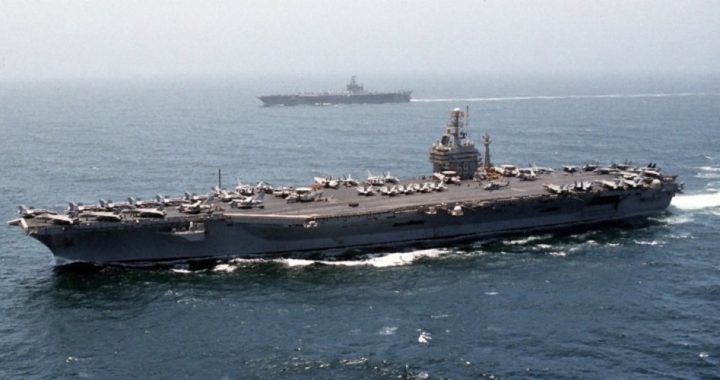
Another U.S. warship moved into waters off the coast of Syria Thursday, according to the Russian-based television network RT, while Syria’s deputy foreign minister accused Western nations of stirring up fears of chemical weapons as a “pretext for invasion.”
“Syria stresses again, for the tenth, the hundredth time, that if we had such weapons, they would not be used against its people. We would not commit suicide,” said Faisal Maqdad, as quoted in a report from the Reuters news service. Meanwhile, RT reported the USS Dwight D. Eisenhower has joined the USS Iwo Jima off the Syrian coast. The Eisenhower, one of 11 U.S. aircraft carriers, holds eight fighter-bomber squadrons and 8,000 men. The Iwo Jima Amphibious Ready Group holds about 2,500 Marines, the report said.
The build up of troop presence follows warnings by U.S. and NATO officials against the use of chemical weapons against the rebel forces trying to overthrow the government of President Bashar al-Assad in a civil war that is 20 months old and has already claimed more than 40,000 lives, Reuters reported. A resort to the chemical weapons would cross a red line, President Obama has said, and would result in “serious consequences.”
“Exactly what Syria’s army has done with suspected chemical weapons to prompt a surge of Western warnings is not clear,” the Reuters report said. “Reports citing Western intelligence and defense sources are vague and inconsistent.”
The RT account also cited a report in an Australian publication of U.S. “special operations” units prepared for action in Syria.
“We have (US) special operations forces at the right posture, they don’t have to be sent,” an unnamed U.S. official told The Australian.
Even as they issue warnings about chemical weapons to the Assad regime, the United States and allied nations are discussing the possibility of sending thousands of ground troops into Syria to prevent those same weapons from falling into the hands of Jihadi groups among the rebel forces.
“There is not an imminent plan to deploy ground forces,” a U.S. official, speaking on condition of anonymity, told Reuters. “This is, in fact, a worst-case scenario.” U.S. Defense Secretary Leon Panetta has stressed the importance of Syrian security forces remaining intact should the regime collapse.
“They do a pretty good job of securing those sites,” Panetta said in an interview with CNN in July. “If they suddenly walked away from that, it would be a disaster to have those chemical weapons fall into the wrong hands, hands of Hezbollah or other extremists in that area.” Israel, along with U.S. and NATO countries, is concerned over the possibility of Hezbollah, an enemy of the Jewish state, obtaining chemical weapons. Sunni Jihad insurgents might also gain access to the weapons in a post-Assad Syria.
Germany’s cabinet, meanwhile, approved stationing Patriot anti-missile batteries on Turkey’s border with Syria, a step requiring deployment of NATO troops and arousing fears of the Assad regime that the move is a prelude of an imposition of a no-fly zone in Syria to protect the rebel forces.
If all of this looks and sounds familiar, it may because the United States and Great Britain enforced a no-fly zone over Iraq for a dozen years before the U.S.-led invasion over chemical and other “weapons of mass destruction,” the existence of which turned out to be based on false and misleading intelligence reports. With U.S. combat units finally out of Iraq and American troops committed to the fighting in Afghanistan through 2014, the American public may be reluctant to see U.S. ground forces sent into Syria based on information from unknown sources cited in intelligence reports.
Photo of USS Dwight D. Eisenhower



